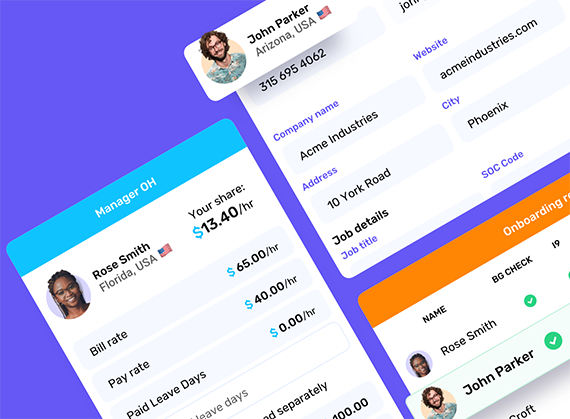In today’s rapidly evolving business landscape, contingent workforce programs—comprised of temporary workers, contractors, freelancers, and other non-permanent talent—are crucial for organizations to remain agile and competitive. Yet, one of the most significant challenges for contingent workforce leaders and talent acquisition teams is communicating the true value of these programs to internal stakeholders and hiring managers.
It’s not just about filling roles; it’s about how contingent talent drives business outcomes, improves efficiency, and provides a flexible solution to workforce demands. Effectively articulating this value is key to ensuring the long-term success of your contingent workforce program.
Here’s how you can clearly communicate that value and demonstrate why a well-structured contingent workforce strategy is vital.
5 Steps to Communicate the Value of Your Contingent Workforce Program
1. Focus on Business Impact, Not Just Headcount
While it might be tempting to highlight the number of roles filled or the total size of the workforce, those metrics alone don’t tell the whole story. What stakeholders really care about is how the contingent workforce impacts key business objectives.
Key Points to Communicate:
- Increased Agility: Contingent workers allow organizations to scale up or down quickly based on market demand. This reduces overhead costs associated with full-time hires and helps businesses adapt to fluctuating workloads or seasonality.
- Cost Efficiency: By utilizing temporary and contract talent, companies can reduce the long-term costs of hiring permanent employees, including benefits, training, and severance packages.
- Access to Specialized Skills: Contingent workers often bring niche expertise or specific skills to a project, helping companies bridge talent gaps without the time or expense of recruiting full-time employees.
How to Communicate: Use data-driven examples to demonstrate how your program helped leadership respond to market shifts or reduced costs during periods of uncertainty. Show how contingent workers supported mission-critical projects without long-term financial commitments.
2. Highlight Flexibility and Risk Mitigation
One of the most significant advantages of a contingent workforce is its ability to provide businesses with flexibility and reduce risk. Organizations can bring in expertise for short-term projects, meet immediate business needs, and easily transition out talent as priorities shift.
Key Points to Communicate:
- Flexible Workforce Solutions: Explain how a contingent workforce allows organizations to remain nimble, filling roles only when they are needed, and mitigating risks related to overstaffing during downturns.
- Risk Mitigation in Compliance: A strong contingent workforce program ensures compliance with labor laws, tax regulations, and employment classifications. Many organizations achieve this by partnering with an Employer of Record (EOR) platform, which handles payroll, compliance, insurance, and other requirements on behalf of their clients.
How to Communicate: Use case studies that show how contingent labor helped stakeholders navigate challenges such as a sudden increase in demand or regulatory complexity. Emphasize your role in handling compliance issues, payroll, and other employment risks.
3. Use Metrics to Quantify Value
Data is powerful when it comes to communicating the success of a contingent workforce program. Businesses are increasingly driven by metrics, and providing quantifiable outcomes is one of the best ways to prove the program’s value.
Key Points to Communicate:
- Time-to-Fill Metrics: How quickly are you able to provide qualified candidates for open roles? A faster time-to-fill can mean less downtime for the business.
- Cost Savings: Showcase the cost efficiencies gained from leveraging contingent labor compared to full-time employees. Provide a breakdown of how much stakeholders have saved on hiring, training, and benefits costs.
- Quality of Hire: Use feedback or performance metrics from the contractors placed to illustrate the quality of the talent provided. High-performance scores or successful project completions can be a strong selling point.
How to Communicate: Present reports that compare contingent workforce performance with traditional hiring models. Include KPIs such as cost per hire, turnover rates, and contractor satisfaction.
4. Demonstrate Strategic Partnership
A strong contingent workforce program does more than fill temporary vacancies; it becomes a strategic partner for the business. Emphasize how your program provides more than just staffing—it offers strategic insights that align with your organization’s long-term goals.
Key Points to Communicate:
- Consultative Approach: Show how your team acts as advisors, helping hiring managers optimize their workforce strategy. This might include recommendations for when to use contingent labor versus permanent hires or advice on market conditions affecting talent availability.
- Workforce Planning: Position your program as part of the broader workforce planning process. You’re not just providing talent on-demand but helping internal teams plan for future workforce needs and build a flexible strategy that supports business growth.
How to Communicate: Share examples of how your recommendations have helped stakeholders save time, increase productivity, or avoid costly hiring mistakes. Highlight instances where you proactively advised leadership to adapt their hiring strategies to market trends.
5. Emphasize Quality Control and Continuous Improvement
Internal stakeholders need to know that your contingent workforce program isn’t a “set it and forget it” program. To drive home the value, communicate how your program emphasizes ongoing quality control, feedback loops, and continuous improvement.
Key Points to Communicate:
- Regular Check-Ins: Explain how you conduct regular reviews with stakeholders and contractors to ensure expectations are being met. These check-ins allow for timely adjustments and ensure everyone is aligned with project goals.
- Feedback-Driven Improvements: Highlight how feedback from both stakeholders and contingent workers informs changes in processes, candidate selection, and engagement strategies. Continuous improvement ensures the program stays effective and aligned with evolving needs.
How to Communicate: Provide examples of how your quality control processes have identified and resolved potential issues early, ensuring higher satisfaction and contractor retention.
Showcasing the Full Value of Your Contingent Workforce Program
A successful contingent workforce program is much more than a temporary staffing solution—it’s a strategic tool that enables businesses to be more agile, efficient, and competitive. By focusing on business outcomes, demonstrating flexibility, leveraging data, and positioning your program as a strategic partner, you can clearly communicate the value of your contingent workforce program to leadership and hiring managers alike.
Ultimately, it’s about illustrating how your program solves critical business challenges, reduces risk, and drives results that go beyond simply placing temporary workers. When communicated effectively, the value of a contingent workforce program becomes undeniable.





